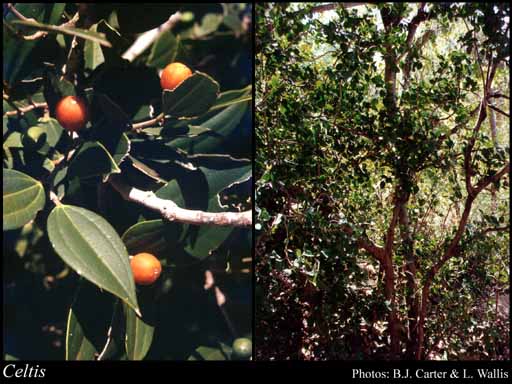- Reference
- Sp.Pl. [Linnaeus] 2:1043 (1753)
- Name Status
- Current







Scientific Description
Common name. Celtis. Family Ulmaceae.
Habit and leaf form. Trees, or shrubs; evergreen, or deciduous. Leaves cauline. Leptocaul. Mesophytic. Leaves alternate; distichous; petiolate; non-sheathing; simple. Leaf blades entire; elliptic, or ovate, or orbicular (to suborbicular); palmately veined (with three main veins); cross-venulate; cordate, or oblique at the base, or rounded at the base. Leaves with stipules. Stipules intrapetiolar; free of one another (lateral, enclosing bud); scarious; caducous. Leaf blade margins entire, or serrate. Vegetative buds scaly. Leaves without a persistent basal meristem. Leaf anatomy. Hairs present, or absent. Stem anatomy. Secondary thickening developing from a conventional cambial ring.
Reproductive type, pollination. Fertile flowers hermaphrodite, functionally male, and functionally female, or functionally male and functionally female. Unisexual flowers present. Plants monoecious, or polygamomonoecious. Female flowers with staminodes (4–5 staminodes), or without staminodes. Male flowers with pistillodes, or without pistillodes. Entomophilous.
Inflorescence and flower features. Flowers solitary, or aggregated in ‘inflorescences’; in cymes, or in racemes, or in panicles. The terminal inflorescence unit cymose, or racemose. Inflorescences axillary (on new shoots); male, female and bisexual flowers either in the same or separate inflorescences. Flowers bracteate (bracts minute). Bracts deciduous (caducous). Flowers small; regular; 4 merous, or 5 merous; cyclic. Free hypanthium absent. Hypogynous disk absent. Perianth sepaline; 4, or 5; 1 -whorled (ostensibly); free. Calyx present; (if the perianth is so interpreted 4, or 5; 1 -whorled; polysepalous; imbricate; regular; persistent. Sepals ovate to elliptic, or linear to oblong. Androecium present, or absent (sometimes, from male flowers). Fertile stamens present, or absent (in female flowers). Androecial members definite in number. Androecium 4–5. Androecial members free of the perianth; all equal; free of one another; 1 -whorled. Androecium exclusively of fertile stamens. Stamens 4–5; all more or less similar in shape; isomerous with the perianth; oppositisepalous; erect in bud, or inflexed in bud (sometimes). Anthers dorsifixed; dehiscing via longitudinal slits; extrorse; tetrasporangiate. Fertile gynoecium present, or absent (male flowers). Gynoecium 2(–3) carpelled. The pistil 1 celled. Carpels reduced in number relative to the perianth. Gynoecium syncarpous; synovarious to eu-syncarpous; superior. Ovary unilocular; 1 locular. Gynoecium median. Ovary sessile (ovoid-ellipsoid). Gynoecium non-stylate, or stylate. Styles 2; free to partially joined; apical. Stigmas 1; 2 - lobed. Placentation apical. Ovules in the single cavity 1; pendulous; non-arillate; campylotropous.
Fruit and seed features. Fruit fleshy (succulent); indehiscent; a drupe. Seeds non-endospermic. Cotyledons 2. Embryo curved.
Etymology. From the Latin for an African lotus.
Taxonomic Literature
- Wheeler, J. R.; Rye, B. L.; Koch, B. L.; Wilson, A. J. G.; Western Australian Herbarium 1992. Flora of the Kimberley region. Western Australian Herbarium.. Como, W.A..
- Australia. Bureau of Flora and Fauna 1989. Flora of Australia. Volume 3, Hamamelidales to Casuarinales. Australian Govt. Pub. Service.. Canberra..